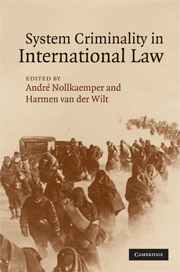Book contents
- Frontmatter
- Contents
- Preface
- Table of cases
- Table of treaties and international instruments
- List of abbreviations
- List of contributors
- 1 Introduction
- 2 The policy context of international crimes
- 3 Why corporations kill and get away with it: the failure of law to cope with crime in organizations
- 4 Men and abstract entities: individual responsibility and collective guilt in international criminal law
- 5 A historical perspective: from collective to individual responsibility and back
- 6 Command responsibility and Organisationsherrschaft: ways of attributing international crimes to the ‘most responsible’
- 7 Joint criminal enterprise and functional perpetration
- 8 System criminality at the ICTY
- 9 Criminality of organizations under international law
- 10 Criminality of organizations: lessons from domestic law – a comparative perspective
- 11 The collective accountability of organized armed groups for system crimes
- 12 Assumptions and presuppositions: state responsibility for system crimes
- 13 State responsibility for international crimes
- 14 Responses of political organs to crimes by states
- 15 Conclusions and outlook
- Index
7 - Joint criminal enterprise and functional perpetration
Published online by Cambridge University Press: 08 October 2009
- Frontmatter
- Contents
- Preface
- Table of cases
- Table of treaties and international instruments
- List of abbreviations
- List of contributors
- 1 Introduction
- 2 The policy context of international crimes
- 3 Why corporations kill and get away with it: the failure of law to cope with crime in organizations
- 4 Men and abstract entities: individual responsibility and collective guilt in international criminal law
- 5 A historical perspective: from collective to individual responsibility and back
- 6 Command responsibility and Organisationsherrschaft: ways of attributing international crimes to the ‘most responsible’
- 7 Joint criminal enterprise and functional perpetration
- 8 System criminality at the ICTY
- 9 Criminality of organizations under international law
- 10 Criminality of organizations: lessons from domestic law – a comparative perspective
- 11 The collective accountability of organized armed groups for system crimes
- 12 Assumptions and presuppositions: state responsibility for system crimes
- 13 State responsibility for international crimes
- 14 Responses of political organs to crimes by states
- 15 Conclusions and outlook
- Index
Summary
Introduction
The joint criminal enterprise doctrine (hereafter JCE) has made quite an impressive appearance on the stage of the International Criminal Tribunal for the Former Yugoslavia. Raised from the ashes of Nuremberg conspiracy law, the doctrine has been enthusiastically embraced by the Tribunal, which has polished the doctrine in order both to meet the principles of criminal law and to face the complexities of international crimes.
The gist of the doctrine is to nail persons who joined forces for a Common purpose to commit (international) crimes and contributed to this aim, although they did not physically perpetrate those crimes. The doctrine connotes group responsibility. However, mere membership does not suffice to incur criminal responsibility, as the ICTY has emphasized correctly.
In the Tadic case, the Appeals Chamber of the ICTY has tried to refine and diversify the doctrine, identifying no fewer than three versions. Whereas the requirements as to the actus reus are basically the same a plurality of persons, membership of this group and an unarticulated ‘contribution’ they differ in the mens rea. The first, relatively straightforward and unproblematic form (JCE (I)) implies that all group members share the common intent to commit certain crimes which actually materialize. The second form (JCE (II)), which has been called the ‘systemic variant’, covers participation in a repressive system in the context of which multiple crimes are committed on a structural basis and has been applied in the so-called ‘concentration camp’ cases.
- Type
- Chapter
- Information
- System Criminality in International Law , pp. 158 - 182Publisher: Cambridge University PressPrint publication year: 2009
- 3
- Cited by



